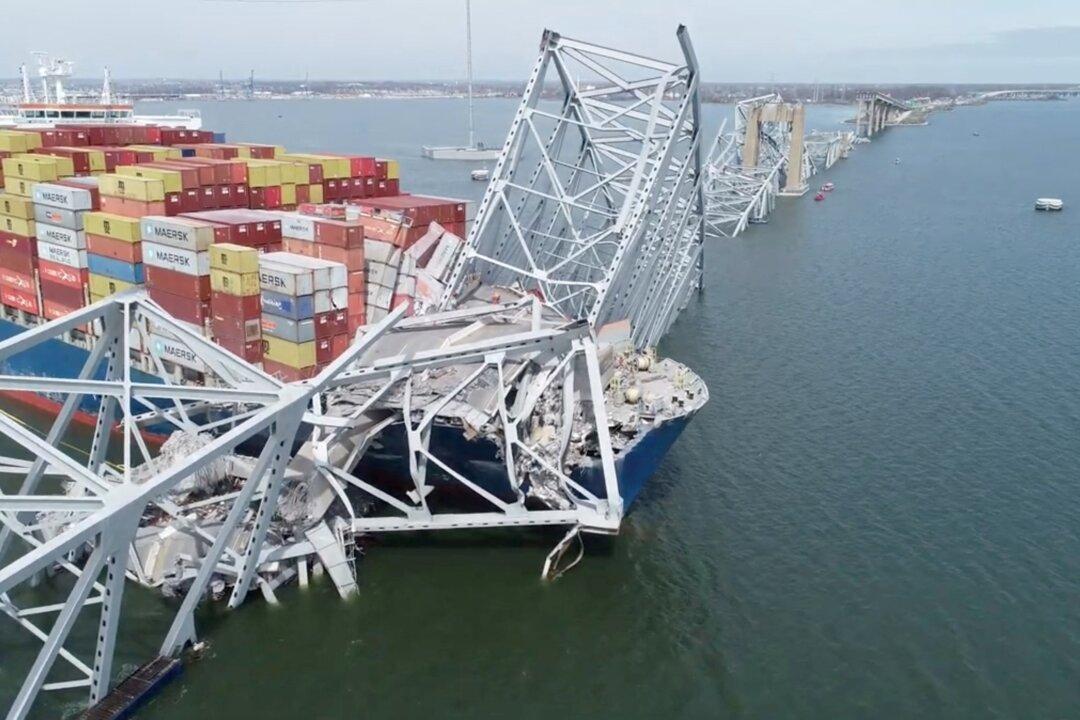BALTIMORE—Rescuers have lost hope of finding more survivors of the Baltimore bridge collapse, the Coast Guard said, as efforts switched on Wednesday to looking for bodies of the missing and more answers to why a container ship smashed into the span.
Search divers were expected to return near dawn to the waters surrounding the twisted ruins of the bridge in Baltimore Harbor to search for six workers missing and now presumed dead.
The disaster has forced the indefinite closure of the Port of Baltimore, one of the busiest on the U.S. Eastern Seaboard, and created a traffic quagmire for Baltimore and the surrounding region.
As the odds of their survival vanished, the search for the missing workers was suspended on Tuesday evening, 18 hours after they were thrown from the fallen Francis Scott Key Bridge into the frigid waters at the mouth of the Patapsco River.
“We do not believe that we’re going to find any of these individuals alive,” Coast Guard Rear Admiral Shannon Gilreath said at a briefing.
Maryland State Police and U.S. Coast Guard officials said diminished visibility and increasingly treacherous currents in the wreckage-strewn channel made continued search efforts on the river too risky to continue overnight.
Starting at 6 a.m. on Wednesday, “we’re hoping to put divers in the water and begin a more detailed search to do our very best to recover those six missing people,” state police Colonel Roland Butler told reporters late on Tuesday.
Rescuers pulled two other workers from the water alive on Tuesday, and one of them was hospitalized. The six presumed to have perished included workers from Mexico, Guatemala, and El Salvador, according to the Mexican Consulate in Washington.
Officials said all eight were part of a work crew repairing potholes on Key Bridge’s road surface when the Singapore-flagged container vessel Dali, leaving Baltimore bound for Sri Lanka, plowed into a support pylon of the bridge at about 1:30 a.m.
A trestled section of the 1.6-mile span almost immediately crumpled into the water, sending vehicles and workers into the river.
The 948-foot ship had reported a loss of propulsion shortly before impact and dropped anchor to slow the vessel, giving transportation authorities time to halt traffic on the bridge before the crash. That move likely prevented a higher death toll, authorities said.
It was unclear whether authorities also tried to alert the work crew ahead of the impact.
Maryland Governor Wes Moore said at a Tuesday news briefing that the bridge was up to code with no known structural issues. There was no evidence of foul play, officials said.

Ship’s Safety Record
The Baltimore wreck drew attention to the vessel’s safety record. The same ship was involved in an incident in the port of Antwerp, Belgium, in 2016, hitting a quay as it tried to exit the North Sea container terminal.An inspection in 2023 carried out in Chile found “propulsion and auxiliary machinery” deficiencies, according to data on the public Equasis website, which provides information on ships.
But Singapore’s Maritime and Port Authority said in a statement that the vessel passed two separate foreign-port inspections in June and September 2023. It said a faulty fuel pressure gauge was rectified before the vessel departed the port following its June 2023 inspection.
Video footage on social media showed the vessel slamming into the Key Bridge in darkness, the headlights of vehicles visible on the span as it crashed into the water and the ship caught fire.
All 22 crew members on the ship, owned by Grace Ocean Pte Ltd, were accounted for, its management company, Synergy Marine Pte Ltd, reported.
U.S. Transportation Secretary Pete Buttigieg said the closure of the port would have a “major and protracted impact to supply chains.” The Port of Baltimore handles more automobile freight than any other U.S. port—more than 750,000 vehicles in 2022, according to port data, as well as container and bulk cargo ranging from sugar to coal.
Still, economists and logistics experts said they doubted the port closure would unleash a major U.S. supply chain crisis or major spike in the price of goods, due to ample capacity at rival shipping hubs along the Eastern Seaboard.
The loss of the bridge also snarled roadways across Baltimore, forcing motorists onto two other congested harbor crossings and raising the specter of nightmarish daily commutes and regional traffic detours for months or even years to come.
The bridge, named for the author of the Star-Spangled Banner, carries about 31,000 vehicles across the harbor daily and serves as the main route for motorists between New York and Washington seeking to avoid downtown Baltimore. It opened in 1977.
President Joe Biden promised on Tuesday to visit Baltimore, 40 miles away, as soon as possible and said he wanted the federal government to pay to rebuild the bridge.
National Transportation Safety Board chair Jennifer Homendy said a team of 24 agency personnel were on the scene to investigate the accident. She said Singapore safety personnel would arrive in Baltimore on Wednesday.
Tuesday’s disaster may be the worst U.S. bridge collapse since 2007, when the I-35W bridge in Minneapolis plunged into the Mississippi River, killing 13 people.







